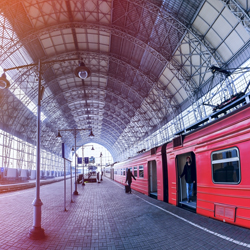 |
| The sheer number of travelers and lack of passport control in the Schengen Area in Europe tests railroad security’s capabilities |
Ayoub El Kahzzan, a Moroccan national who had spent time in Syria, allegedly attempted to open fire on passengers in a train from Amsterdam to Paris last month. Prosecutors claim that he was carrying a Luger pistol, a Kalashnikov, a box-cutter knife and a bottle of petrol. He slashed at one passenger and fired off a few rounds before the rifle’s primer failed. He was subdued promptly by travellers including two vacationing U.S. servicemen. El Kahzzan was known to authorities in France, Belgium and Spain. He had also attended a mosque in Algeciras on the southern coast of Spain that had been under police surveillance.
And that is as far as we need go with the precise details of the case other than noting that 550 people were on board the train (this being more than the capacity of a typical Boeing 747) and it had passed through three countries. But might available and imminent security products or services be able to address such threats? Protecting train passengers has been a priority for our sector since 191 people died in Madrid from three coordinated bombings in March 2004. It would be foolish to expect train operators and infrastructure managers to give out much information, but it’s difficult not to conclude that progress since the 2004 atrocity has been slight.
Challenges of screening & surveillance at major transport hubs
Sheer numbers present the main hurdle on rail networks and the task of screening the 260,000 people a day who go through Amsterdam Central (the departure point of the Thalys high-speed train in question) is clearly not a viable one. Few people would be willing to present themselves at a train station more than ten minutes prior to departure for such screening, and any attempt at surveillance of this kind would simply block Europe’s motorways.
El Kahzzan’s fingerprints were on file (presumably accompanied by a mugshot), but facial recognition on this scale at a major rail hub is the stuff of fantasy in terms of our current biometric and database capabilities. It would also meet opposition (quite rightly) from the civil rights lobby. A crucial factor here is the abolition of passport control within the 26 European countries that make up the Schengen Zone. Realists working in both security and politics acknowledge that we don’t exist in a vacuum and, literally as I type, German Chancellor Angela Merkel is waiving certain visa checks as the build-up of refugees fleeing the war in Syria increases.
Extensive behind-the-scenes security screenings
Sheer numbers present the main hurdle on rail networks and the task of screening the 260,000 people a day who go through Amsterdam Central (the departure point of the Thalys high-speed train in question) is clearly not a viable one |
If body searches and biometric screening are more or less out of the question, the technological outlook for analysing passenger luggage on inter-continental trains is far more encouraging, though we should be realistic about likely increases to boarding times. The weighing and initial scanning of your hold luggage at an airline check-in desk while it’s still in your sight probably represents less than 5% of the total time spent scrutinising it. Behind the scenes there will be extensive x-raying and use of sniffer dogs who can only work a 20-minute shift before resting for 40 minutes. Of course use of dogs while a train is in motion is achievable but anybody who has struggled simply to make headway down the corridor of a Eurostar train will rule this out, and the prospect conjures up scenes from bad war movies.
Eurostar trains in and out of London are an exception to much of the analysis here since Britain is not a signatory to the Schengen Area agreement. Screening of luggage and the attention of immigration officials to travellers on these trains can often be as scrupulous as that paid to air passengers though the layout of a train station (as opposed to an airport) must be a nightmare for officials since there is more scope for would-be terrorists to conduct hostile reconnaissance.
Fuel vapour detection is achievable with simple hand-held devices, but El Kahzzan’s possession of a bottle of petrol is so bizarre (and such a threat to himself even before completing whatever he saw as his ultimate mission) that it can be ruled out as a regular tactic of future jihadists. Intending to discuss overall issues here rather than the circumstances of the recent incident on the Belgian-French border, I return to it only to point out that it is not necessarily a template from which we should seek to learn. El Kahzzan’s bizarre arsenal and his incompetence suggest that he was a lone wolf with no logistical support from Al-Qaeda and its affiliates.
Reintroduce passport control in Schengen Area?
EU transport ministers will face pressure to reintroduce passport control as trains cross international borders within the Schengen Area. Of course, this will only alert controllers to known or suspected criminals and will provide no protection against seasoned terrorists travelling on stolen or forged papers |
One simple strategy for the operators of inter-continental trains does suggest itself. EU transport ministers are due to meet in early October. They will face pressure to reintroduce passport control as trains cross international borders within the Schengen Area. Of course, this will only alert controllers to known or suspected criminals and will provide no protection against seasoned terrorists travelling on stolen or forged papers. Proactively sharing intelligence across borders by issuing train guards with smart devices that can access international passport databases is eminently achievable and the costs – which could be shared by multiple stakeholders – would be significant but by no means prohibitive. The profile of certain guards could also be heightened to that of a marshal.
There is of course a dampener to even the modest optimism that might come from taking such measures. The jihadist mentality seeks to attack secular communities and any society adhering to religious beliefs alien to its own. A common theme running through recent targets has been material wealth; it is no coincidence that the World Trade Center was attacked twice. Passengers on the train in question included the film star Jean-Hugues Anglade and many others aboard would have been affluent.
This Thalys express train was a high-profile target but even a cursory glance at the timetable out of Amsterdam shows that there are services with comparably extensive rolling stock (and thus passenger numbers) to every major city in Holland. Travellers would not be so wealthy and there would be few if any Americans in their number. We can at least take a modicum of comfort from what will be an inevitable increase across Europe in metal detectors, spot checks on ID, random examination of luggage and engagement between police and passengers that will contribute to general awareness of threats.










































